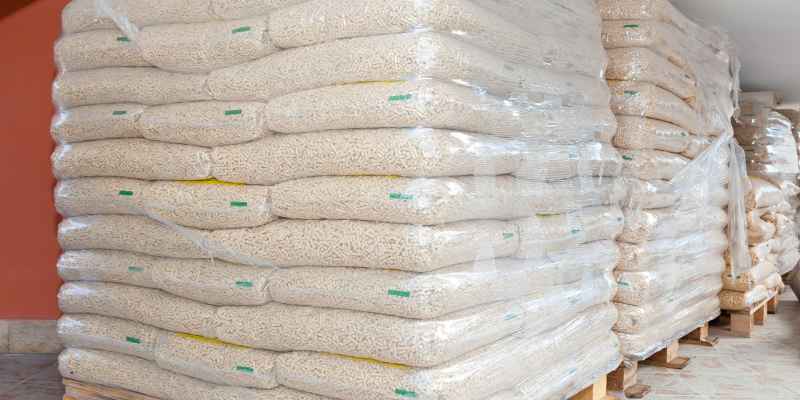A standard pallet of wood pellets typically contains 50 bags. Wood pellets have gained immense popularity as a source of renewable and eco-friendly heating fuel due to their low cost and high efficiency.
As the world is moving towards more sustainable energy options, people are turning to wood pellets to reduce their carbon footprint. But, before investing in a pallet of wood pellets, it is essential to know the number of bags it contains to make an informed decision.
We will discuss the factors that affect the number of bags in a pallet of wood pellets and answer the frequently asked questions related to this topic.
Understanding Wood Pellets
A typical pallet of wood pellets contains around 50 bags of fuel, each weighing 40 pounds. These pellets are a cleaner and efficient heating solution to traditional wood for heating homes and commercial facilities.
What Are Wood Pellets?
Wood pellets are small, cylindrical, compressed wood particles, usually made from sawdust or wood shavings. They are a renewable source of energy and an environmentally friendly alternative to fossil fuels. They burn hot and clean, producing little ash or smoke. Wood pellets are used for residential heating, as well as for commercial and industrial applications.
Benefits Of Using Wood Pellets
The benefits of using wood pellets are numerous. First, they are a renewable source of energy that reduces our dependence on non-renewable resources. Second, wood pellets are relatively inexpensive compared to other heating fuels. Third, they are environmentally friendly, producing less carbon dioxide than fossil fuels. Fourth, using wood pellets can help reduce our carbon footprint and contribute to a cleaner environment. Finally, they are easy to store and use, making them a convenient choice for homeowners and businesses alike.
A pallet of wood pellets typically contains 50 to 100 bags, depending on the manufacturer. Each bag usually weighs around 40 pounds, so a full pallet can weigh anywhere from 2000 to 4000 pounds. The exact number of bags in a pallet may vary depending on the size of the bags, the density of the pellets, and the weight capacity of the pallet.
If you’re thinking of buying wood pellets, it’s important to check the bag and pallet sizes with your supplier. This will help ensure that you have enough pellets to get through the winter and that you can store them safely and effectively.
Calculating Pellet Needs
Are you wondering how many bags of wood pellets you need per pallet? Typically, a pallet of wood pellets contains 50 bags. However, it’s important to calculate your specific pellet needs based on your heating requirements and the size of your space.
Determining Pellet Needs
Calculating the number of wood pellet bags required depends on several factors. The size of the house and climate are vital in determining your pellet need. You’ll need more pellets to heat a bigger house or in cold climates. On the other hand, a small house and a mild climate will require fewer pellets.
How Many Pellets Required To Heat A Home?
To determine the number of bags required, first, calculate the number of BTUs needed to heat your home. You can calculate the BTUs by multiplying the square footage of your home by 30 for cold climates and 20 for mild climates. Then, divide the BTUs required by the number of BTUs in one ton of wood pellets, which is 16,500 for most pellets.
For instance, a 2,000 square feet house in a cold climate requires 60,000 BTUs to heat (2,000 x 30). If you divide that by 16,500, you get 3.64. Therefore, you’ll need approximately four tons of pellets to heat your home. A ton of pellets contains about 50 bags of pellets, which makes it roughly 200 bags required.
Conclusion:
In conclusion, calculating the number of wood pellet bags required to heat your home depends on several factors. Understanding these factors will enable you to determine your pellet needs, ensuring you have enough pellets and avoid running out in the middle of the winter. Remember to store your pellets in a dry, clean, and safe place to prevent damage and fire hazards.
Standard Wood Pellet Packaging

A standard pallet of wood pellets typically contains up to 50 bags, with each bag weighing approximately 40 pounds. This can vary depending on the supplier, so it’s best to confirm with them before making a purchase. Pellets are an eco-friendly and cost-effective heating source.
Wood pellets have become increasingly popular as a fuel source because they are an eco-friendly, renewable source of energy. Whether you are a homeowner looking to heat your home or a business seeking sustainable energy solutions, you may have wondered how many bags of pellets are in a pallet. Understanding the standard wood pellet packaging can help you make informed decisions about your fuel needs and storage options.
Dimensions Of Wood Pellet Bags
The size of wood pellet bags can vary depending on the manufacturer, but they typically measure 40 pounds in weight and 3 cubic feet in volume. The dimensions of the bag can vary according to the shape of the pellet, but bags are generally 16 to 22 inches in height and 12 to 14 inches in width. It’s important to note that the weight and volume of the bag can affect how many bags can fit on a pallet.
Typical Size Of A Pallet Of Wood Pellets
A standard pallet of wood pellets contains 50 bags, with each bag weighing 40 pounds. This means that a full pallet will weigh 2,000 pounds and equal to one ton of wood pellets. A pallet is typically 4 feet in height, 4 feet in width, and 3.5 feet in depth. It’s important to keep in mind that the weight and size of the pallet may vary by manufacturer, but most use a standard size.
To ensure safe and efficient storage, it’s crucial to have a clear understanding of the standard wood pellet packaging. By knowing how many bags are in a pallet, you can make informed decisions about your storing needs and budget. Whether you’re purchasing pellets for home heating or large-scale commercial operations, understanding the size and dimensions of the packaging can help you better plan for your fuel needs.
How Many Bags In A Pallet Of Wood Pellets?
A standard pallet of wood pellets usually contains 50 bags. This may vary depending on the brand and size of the bags. It’s important to know the number of bags per pallet when ordering to ensure you have enough for your heating needs.
If you are new to using wood pellets for heating or grilling, you might wonder how many bags of wood pellets are on a pallet. It’s important to know the number of bags per pallet so that you can calculate the total amount of pellets you need to purchase or store. In this article, we will discuss the average number of bags per pallet, as well as factors that affect this number.
Factors Affecting Number of Bags per Pallet
The number of bags per pallet of wood pellets can vary depending on several factors. Here are some of the factors that can affect the number of bags per pallet:
1. Bag Size: The size of the bags can affect the number of bags per pallet. Standard wood pellet bags are usually 40-pounds each, but some manufacturers offer bags that are 20 to 50 pounds.
2. Pallet Size: The size of the pallet also affects the number of bags per pallet. Standard wood pellet pallets can hold between 50 to 100 bags of wood pellets.
3. Density: The density of the wood pellets can also affect the number of bags per pallet. Some wood pellets are denser than others, so a pallet of dense wood pellets will have fewer bags than a pallet of less dense pellets.
4. Moisture Content: The moisture content of the wood pellets can also affect the number of bags per pallet. Wood pellets with a higher moisture content will weigh more, so fewer bags will fit on a pallet.
Average Number of Bags per Pallet
The standard size of a wood pellet bag is 40-pounds. A standard pallet can hold between 50 to 100 bags of wood pellets, depending on the size and weight of the bags. So, the average number of bags per pallet of wood pellets is around 80 bags.
However, it’s important to note that the number of bags per pallet can vary depending on the manufacturer, bag size, and other factors mentioned above. Therefore, it’s always best to check with the supplier to know the exact number of bags per pallet.
In conclusion, the number of bags per pallet of wood pellets can vary depending on several factors including bag size, pallet size, density, and moisture content. While the average number of bags per pallet is around 80 bags, it’s essential to check with the supplier to know the exact number of bags per pallet.
Buying Wood Pellets
A pallet of wood pellets typically contains 50 bags, although the weight per bag and the total weight of the pallet can vary depending on the supplier. It’s important to check the specifications of each pallet before making your purchase.
If you’re thinking of buying wood pellets, you might be wondering how many bags come in a pallet of wood pellets, where to buy them, and the price per ton of wood pellets. In this article, we’ll cover all the details you need to know.
Where to Buy Wood Pellets
When it comes to buying wood pellets, there are several options available, including local hardware stores, home improvement stores, online retailers, and direct from manufacturers. Some popular brands available in stores include Lignetics, Flame Genie, Golden Fire, Camp Chef, and Traeger. It’s important to do your research and read reviews to find the best brand and supplier for your needs.
Price of Wood Pellets per Ton
The price of wood pellets varies depending on the brand, supplier, and your location. On average, you can expect to pay between $200-$300 per ton for wood pellets. However, some brands may be more expensive due to their high quality or popularity. It’s important to compare prices from different suppliers to find the best deal.
Pros and Cons of Different Brands
There are several different brands of wood pellets available, each with their pros and cons. Lignetics is a popular brand known for its high quality and low ash content. Flame Genie pellets are made from 100% natural wood and do not contain any binding agents or chemicals. Golden Fire pellets are made from recycled wood and have a high heat output.
Camp Chef pellets are designed specifically for use with pellet grills and smokers and have a unique blend of hardwoods and fruitwoods. Traeger pellets are known for their consistent quality and come in a variety of flavors. It’s important to consider the pros and cons of different brands to find the best one for your needs.
In conclusion, when buying wood pellets, it’s important to consider where to buy them, the price per ton, and the pros and cons of different brands. By doing your research and comparing prices and reviews, you can find the best wood pellets for your heating or grilling needs.

Storage And Handling
A pallet of wood pellets typically contains 50 bags, but this can vary depending on the manufacturer. Proper storage and handling of these bags is important for maintaining their quality and avoiding damage during transport.
Storing Wood Pellets Safely
When it comes to storing wood pellets safely, it’s important to keep some critical tips in mind. These pellets are an excellent source of energy, but they require careful handling to maintain their quality and prevent safety hazards. Here are some important tips to keep in mind:
- Store wood pellets in a dry, well-ventilated area to prevent moisture buildup, which can cause pellets to break down and become unusable.
- Keep wood pellets away from sources of heat and fire, such as heaters and stoves, as they can ignite and cause fire hazards.
- Stack wood pellet bags in a stable and organized manner to prevent them from falling and causing injuries or damage.
- Store wood pellets away from other chemicals or substances to prevent contamination or dangerous chemical reactions.
- Be mindful of the “best by” date on the packaging and use the pellets within this timeframe to maintain their quality.
Tips For Handling Wood Pellets
Handling wood pellets safely is just as important as storing them correctly. Here are some practical tips to keep in mind when handling wood pellets:
- Wear personal protective equipment, such as gloves and a dust mask when handling wood pellets to prevent skin irritation and respiratory problems.
- Handle wood pellet bags with care to prevent ripping and exposure to moisture, which can cause damage to the pellets.
- Use appropriate lifting and carrying techniques when moving pellet bags to prevent injuries and strains.
- Be cautious when using tools or equipment for handling pellets as they can cause damage to the bags and lead to safety hazards.
- Only open wood pellet bags when needed to prevent moisture exposure and maintain their quality.
By following these tips for storing and handling wood pellets, you can maintain their quality and avoid safety hazards. Make sure to take the necessary precautions to keep yourself and others safe when working with wood pellets.
Frequently Asked Questions Of How Many Bags In A Pallet Of Wood Pellets
How Many Pellet Bags Are In A Pallet?
A standard pallet of wood pellets typically contains 50 bags.
How Many 40-pound Bags In A Ton Of Pellets?
There are 50 bags in a ton of pellets, assuming each bag weighs 40 pounds.
How Big Is A Pallet Of Wood Pellets?
A pallet of wood pellets usually contains 50 bags of pellets.
How Many Pellets In A 40 Lb Bag?
There are typically around 50 bags of pellets in a 40 lb bag pallet.
Conclusion
To conclude, it is important to understand how many bags are in a pallet of wood pellets when buying in bulk. The standard number of bags in a pellet pallet varies from 40-75 depending on the brand and weight per bag.
It is recommended to do some research and compare prices before making a purchase from any of the numerous brands available. By doing so, you can ensure to get your money’s worth while also finding the ideal quantity of bags for your demands and budget.


